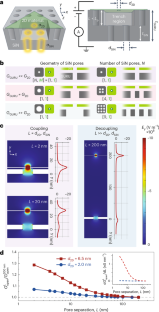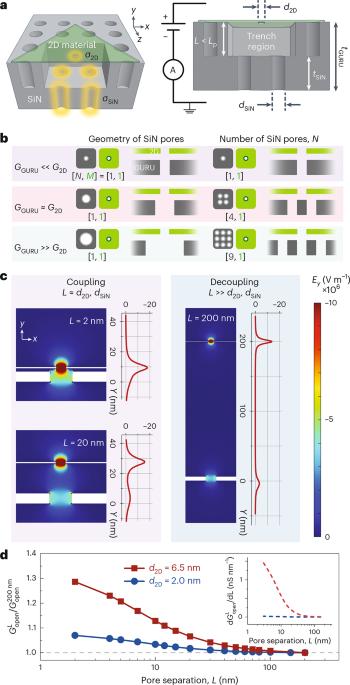Coupled nanopores for single-molecule detection
IF 38.1
1区 材料科学
Q1 MATERIALS SCIENCE, MULTIDISCIPLINARY
引用次数: 0
Abstract
Rapid sensing of molecules is increasingly important in many studies and applications, such as DNA sequencing and protein identification. Here, beyond atomically thin 2D nanopores, we conceptualize, simulate and experimentally demonstrate coupled, guiding and reusable bilayer nanopore platforms, enabling advanced ultrafast detection of unmodified molecules. The bottom layer can collimate and decelerate the molecule before it enters the sensing zone, and the top 2D pore (~2 nm) enables position sensing. We varied the number of pores in the bottom layer from one to nine while fixing one 2D pore in the top layer. When the number of pores in the bottom layer is reduced to one, sensing is performed by both layers, and distinct T- and W-shaped translocation signals indicate the precise position of molecules and are sensitive to fragment lengths. This is uniquely enabled by microsecond resolution capabilities and precision nanofabrication. Coupled nanopores represent configurable multifunctional systems with inter- and intralayer structures for improved electromechanical control and prolonged dwell times in a 2D sensing zone. In this study, the authors present the design and fabrication of reusable, atomically thin, coupled bilayer solid-state nanopores that enable the slowing down and positional tracking of molecules for label-free, single-molecule sensing.


用于单分子检测的耦合纳米孔
在 DNA 测序和蛋白质鉴定等许多研究和应用中,分子的快速感应越来越重要。在这里,除了原子级薄的二维纳米孔之外,我们还构思、模拟并实验演示了耦合、导向和可重复使用的双层纳米孔平台,从而实现了对未修饰分子的先进超快检测。底层可在分子进入传感区之前对其进行准直和减速,而顶层的二维孔(约 2 纳米)则可实现位置传感。我们在顶层固定一个二维孔的同时,将底层的孔数量从一个变为九个。当底层孔的数量减少到一个时,两层都能进行感应,不同的 T 形和 W 形易位信号显示分子的精确位置,并对片段长度敏感。微秒级的分辨率能力和精密的纳米制造工艺使这一独特功能得以实现。耦合纳米孔是可配置的多功能系统,具有层间和层内结构,可改善机电控制并延长二维传感区的停留时间。
本文章由计算机程序翻译,如有差异,请以英文原文为准。
求助全文
约1分钟内获得全文
求助全文
来源期刊

Nature nanotechnology
工程技术-材料科学:综合
CiteScore
59.70
自引率
0.80%
发文量
196
审稿时长
4-8 weeks
期刊介绍:
Nature Nanotechnology is a prestigious journal that publishes high-quality papers in various areas of nanoscience and nanotechnology. The journal focuses on the design, characterization, and production of structures, devices, and systems that manipulate and control materials at atomic, molecular, and macromolecular scales. It encompasses both bottom-up and top-down approaches, as well as their combinations.
Furthermore, Nature Nanotechnology fosters the exchange of ideas among researchers from diverse disciplines such as chemistry, physics, material science, biomedical research, engineering, and more. It promotes collaboration at the forefront of this multidisciplinary field. The journal covers a wide range of topics, from fundamental research in physics, chemistry, and biology, including computational work and simulations, to the development of innovative devices and technologies for various industrial sectors such as information technology, medicine, manufacturing, high-performance materials, energy, and environmental technologies. It includes coverage of organic, inorganic, and hybrid materials.
 求助内容:
求助内容: 应助结果提醒方式:
应助结果提醒方式:


